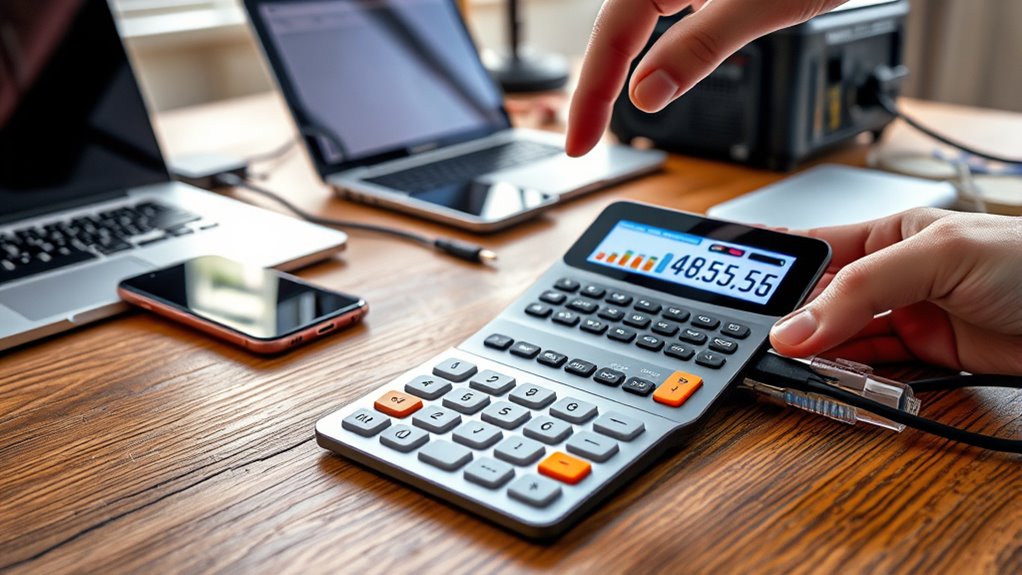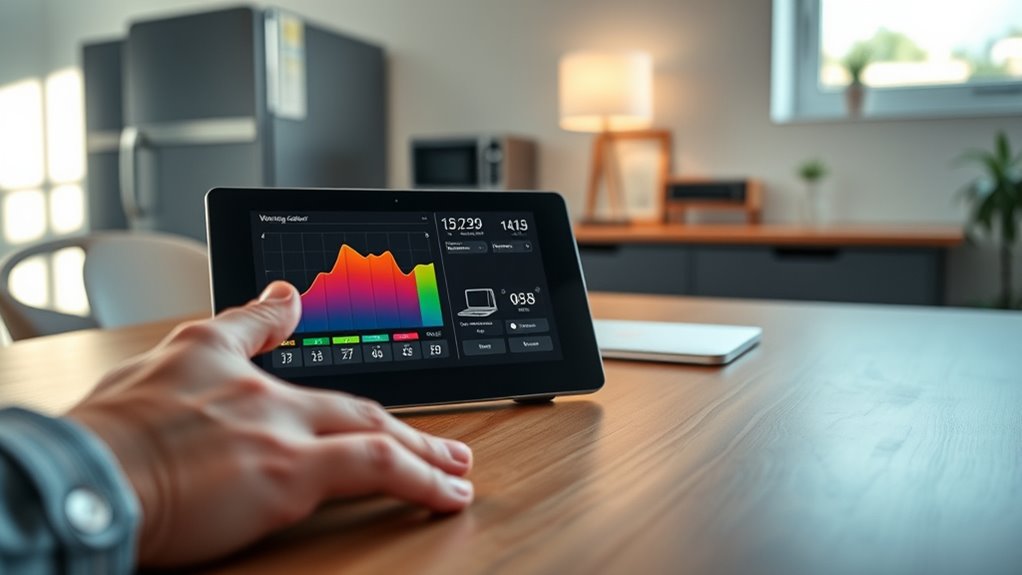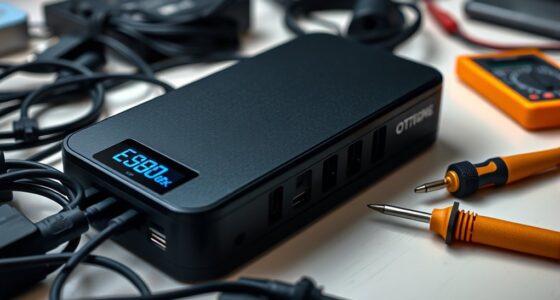To estimate your power needs, list all devices you’ll run and note their wattage ratings. Add these figures, considering startup surges for appliances like refrigerators or pumps, and add a 20-25% buffer for safety. Use a wattage calculator to simplify the process and convert total wattage into battery capacity. If you keep these tips in mind, you’ll be better prepared to choose a reliable power system that matches your demands.
Key Takeaways
- List all devices and record their wattage ratings from labels or manuals.
- Add individual wattages and include a 20-25% buffer for surges and unexpected use.
- Convert total wattage to amp-hours by dividing by battery voltage (e.g., 12V).
- Prioritize energy-efficient devices to reduce overall power requirements.
- Choose a battery capacity that exceeds your total estimated load, accounting for aging and safety margin.

Have you ever wondered how to accurately determine your power needs? Understanding your energy consumption is vital to avoid overloading your system or wasting money on unnecessary capacity. One of the key aspects of this process is calculating your battery capacity, which directly influences how long your devices can run without needing a recharge. To do this effectively, you need to assess the total wattage of all the devices you plan to power and how often they’ll be in use. By doing so, you can choose a battery system that matches your needs, guaranteeing you have enough stored energy when you need it most.
Start by listing all your devices and appliances, then note their wattage ratings, which are usually found on labels or in user manuals. Add these wattages together to get a total power requirement. Keep in mind that some equipment, like refrigerators or pumps, may have startup surges that temporarily demand more power. Incorporating a buffer—around 20-25%—into your calculations helps accommodate these surges and accounts for unexpected increases in consumption. This step is essential because underestimating your needs could lead to insufficient battery capacity, while overestimating might result in unnecessary expenses.
List all devices, note wattages, and add a 20-25% buffer for surges and unexpected consumption.
Energy efficiency plays a significant role in your overall power planning. Devices with higher energy efficiency consume less power to perform the same tasks, which means you can operate longer on a given battery capacity. When estimating your power needs, consider replacing less efficient appliances with models that have better energy ratings. Doing so not only reduces your immediate power requirements but also minimizes strain on your battery system, prolonging its lifespan. Focusing on energy efficiency also helps you optimize your system’s performance, ensuring you get the maximum runtime from your stored energy.
Once you have a clear picture of your total wattage and the efficiency of your devices, you can determine the appropriate battery capacity. This involves converting your total power needs into amp-hours (Ah) based on the voltage of your battery system. For example, if your total wattage is 500W and you’re using a 12V battery, dividing 500W by 12V gives approximately 41.7 Ah. To guarantee reliability and account for factors like battery aging and loss of capacity over time, it’s wise to select a battery with a higher capacity than your minimum calculation. Additionally, understanding the importance of Honda Tuning principles can guide you in selecting performance upgrades that optimize your vehicle’s power output and efficiency, much like ensuring your power system is well-tuned for maximum performance.
Frequently Asked Questions
How Accurate Are Wattage Calculators for Complex Systems?
Wattage calculators are helpful but may not be perfectly accurate for complex systems. They give a good estimate, but factors like energy efficiency and hardware compatibility can influence actual power needs. You should consider potential upgrades or additional components that might increase consumption. Always review your system’s specifications and use the calculator as a guide, not a definitive answer, to ensure your power supply meets your system’s demands.
Can Power Needs Change Over Time?
Your power needs can definitely change over time due to factors like power fluctuations and seasonal variations. As your devices age or new ones are added, your energy consumption may increase or decrease. Weather changes can also impact your system’s efficiency. Regularly reassessing your wattage requirements helps you stay prepared for these shifts, ensuring your system remains reliable and efficient throughout different seasons and life stages.
Do I Need to Factor in Power Surges?
Imagine a sudden lightning bolt striking your home, causing a power surge. Yes, you need to factor in power surges when estimating your needs. Surge protection devices act like a shield, preventing damage to your equipment during unexpected spikes. Including surge protection in your setup guarantees your devices stay safe, saving you money and frustration. Always plan for these surges to keep your power system reliable and protected.
How Do I Account for Future Hardware Upgrades?
When planning for future hardware upgrades, consider hardware longevity to guarantee your power supply can handle increased demands down the line. Incorporate some headroom in your wattage calculations, so you’re not constantly upgrading your power supply with each new component. Think ahead during upgrade planning, and choose a wattage capacity that comfortably supports current and future hardware, preventing potential power issues and ensuring smooth performance as your system evolves.
Is Online Wattage Estimation Sufficient for Professional Setups?
Thinking of online wattage estimation as a quick map is tempting, but for professional setups, it’s just the first step. You need to make certain hardware compatibility and prioritize energy efficiency for peak performance. While online tools give a good starting point, consulting with an expert or using detailed calculations guarantees your system handles future upgrades and power demands accurately. Don’t rely solely on online estimates—think of it as a rough sketch, not the final blueprint.
Conclusion
Remember, knowing your power needs is like having a crystal ball—you avoid surprises and keep things running smoothly. Use the wattage calculator to get an accurate estimate, and don’t forget the golden rule: “Better safe than sorry.” It’s always wise to add a little extra capacity for future upgrades or unexpected surges. By staying proactive, you guarantee your devices stay powered up and your peace of mind stays intact.









